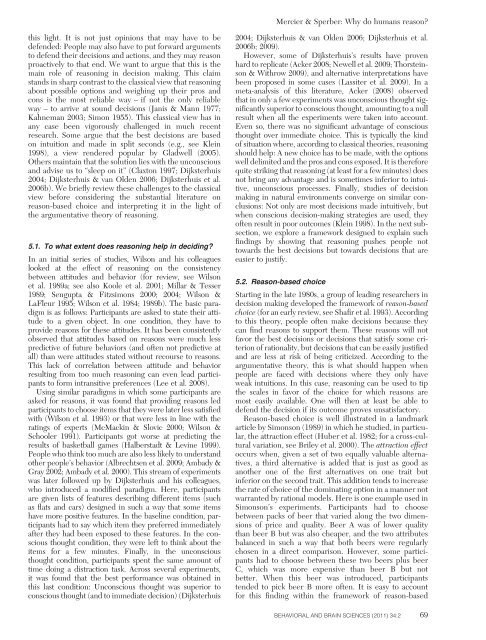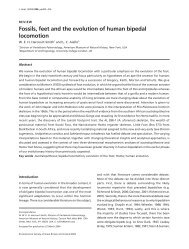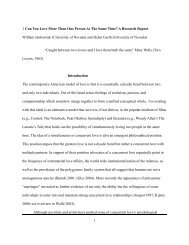Why do humans reason? Arguments for an argumentative theory
Why do humans reason? Arguments for an argumentative theory
Why do humans reason? Arguments for an argumentative theory
You also want an ePaper? Increase the reach of your titles
YUMPU automatically turns print PDFs into web optimized ePapers that Google loves.
Mercier & Sperber: <strong>Why</strong> <strong>do</strong> <strong>hum<strong>an</strong>s</strong> <strong>reason</strong>?this light. It is not just opinions that may have to bedefended: People may also have to put <strong>for</strong>ward argumentsto defend their decisions <strong>an</strong>d actions, <strong>an</strong>d they may <strong>reason</strong>proactively to that end. We w<strong>an</strong>t to argue that this is themain role of <strong>reason</strong>ing in decision making. This claimst<strong>an</strong>ds in sharp contrast to the classical view that <strong>reason</strong>ingabout possible options <strong>an</strong>d weighing up their pros <strong>an</strong>dcons is the most reliable way – if not the only reliableway – to arrive at sound decisions (J<strong>an</strong>is & M<strong>an</strong>n 1977;Kahnem<strong>an</strong> 2003; Simon 1955). This classical view has in<strong>an</strong>y case been vigorously challenged in much recentresearch. Some argue that the best decisions are base<strong>do</strong>n intuition <strong>an</strong>d made in split seconds (e.g., see Klein1998), a view rendered popular by Gladwell (2005).Others maintain that the solution lies with the unconscious<strong>an</strong>d advise us to “sleep on it” (Claxton 1997; Dijksterhuis2004; Dijksterhuis & v<strong>an</strong> Olden 2006; Dijksterhuis et al.2006b). We briefly review these challenges to the classicalview be<strong>for</strong>e considering the subst<strong>an</strong>tial literature on<strong>reason</strong>-based choice <strong>an</strong>d interpreting it in the light ofthe <strong>argumentative</strong> <strong>theory</strong> of <strong>reason</strong>ing.5.1. To what extent <strong>do</strong>es <strong>reason</strong>ing help in deciding?In <strong>an</strong> initial series of studies, Wilson <strong>an</strong>d his colleagueslooked at the effect of <strong>reason</strong>ing on the consistencybetween attitudes <strong>an</strong>d behavior (<strong>for</strong> review, see Wilsonet al. 1989a; see also Koole et al. 2001; Millar & Tesser1989; Sengupta & Fitzsimons 2000; 2004; Wilson &LaFleur 1995; Wilson et al. 1984; 1989b). The basic paradigmis as follows: Particip<strong>an</strong>ts are asked to state their attitudeto a given object. In one condition, they have toprovide <strong>reason</strong>s <strong>for</strong> these attitudes. It has been consistentlyobserved that attitudes based on <strong>reason</strong>s were much lesspredictive of future behaviors (<strong>an</strong>d often not predictive atall) th<strong>an</strong> were attitudes stated without recourse to <strong>reason</strong>s.This lack of correlation between attitude <strong>an</strong>d behaviorresulting from too much <strong>reason</strong>ing c<strong>an</strong> even lead particip<strong>an</strong>tsto <strong>for</strong>m intr<strong>an</strong>sitive preferences (Lee et al. 2008).Using similar paradigms in which some particip<strong>an</strong>ts areasked <strong>for</strong> <strong>reason</strong>s, it was found that providing <strong>reason</strong>s ledparticip<strong>an</strong>ts to choose items that they were later less satisfiedwith (Wilson et al. 1993) or that were less in line with theratings of experts (McMackin & Slovic 2000; Wilson &Schooler 1991). Particip<strong>an</strong>ts got worse at predicting theresults of basketball games (Halberstadt & Levine 1999).People who think too much are also less likely to underst<strong>an</strong><strong>do</strong>ther people’s behavior (Albrechtsen et al. 2009; Ambady &Gray 2002; Ambady et al. 2000). This stream of experimentswas later followed up by Dijksterhuis <strong>an</strong>d his colleagues,who introduced a modified paradigm. Here, particip<strong>an</strong>tsare given lists of features describing different items (suchas flats <strong>an</strong>d cars) designed in such a way that some itemshave more positive features. In the baseline condition, particip<strong>an</strong>tshad to say which item they preferred immediatelyafter they had been exposed to these features. In the consciousthought condition, they were left to think about theitems <strong>for</strong> a few minutes. Finally, in the unconsciousthought condition, particip<strong>an</strong>ts spent the same amount oftime <strong>do</strong>ing a distraction task. Across several experiments,it was found that the best per<strong>for</strong>m<strong>an</strong>ce was obtained inthis last condition: Unconscious thought was superior toconscious thought (<strong>an</strong>d to immediate decision) (Dijksterhuis2004; Dijksterhuis & v<strong>an</strong> Olden 2006; Dijksterhuis et al.2006b; 2009).However, some of Dijksterhuis’s results have provenhard to replicate (Acker 2008; Newell et al. 2009; Thorsteinson& Withrow 2009), <strong>an</strong>d alternative interpretations havebeen proposed in some cases (Lassiter et al. 2009). In ameta-<strong>an</strong>alysis of this literature, Acker (2008) observedthat in only a few experiments was unconscious thought signific<strong>an</strong>tlysuperior to conscious thought, amounting to a nullresult when all the experiments were taken into account.Even so, there was no signific<strong>an</strong>t adv<strong>an</strong>tage of consciousthought over immediate choice. This is typically the kin<strong>do</strong>f situation where, according to classical theories, <strong>reason</strong>ingshould help: A new choice has to be made, with the optionswell delimited <strong>an</strong>d the pros <strong>an</strong>d cons exposed. It is there<strong>for</strong>equite striking that <strong>reason</strong>ing (at least <strong>for</strong> a few minutes) <strong>do</strong>esnot bring <strong>an</strong>y adv<strong>an</strong>tage <strong>an</strong>d is sometimes inferior to intuitive,unconscious processes. Finally, studies of decisionmaking in natural environments converge on similar conclusions:Not only are most decisions made intuitively, butwhen conscious decision-making strategies are used, theyoften result in poor outcomes (Klein 1998). In the next subsection,we explore a framework designed to explain suchfindings by showing that <strong>reason</strong>ing pushes people nottowards the best decisions but towards decisions that areeasier to justify.5.2. Reason-based choiceStarting in the late 1980s, a group of leading researchers indecision making developed the framework of <strong>reason</strong>-basedchoice (<strong>for</strong> <strong>an</strong> early review, see Shafir et al. 1993). Accordingto this <strong>theory</strong>, people often make decisions because theyc<strong>an</strong> find <strong>reason</strong>s to support them. These <strong>reason</strong>s will notfavor the best decisions or decisions that satisfy some criterionof rationality, but decisions that c<strong>an</strong> be easily justified<strong>an</strong>d are less at risk of being criticized. According to the<strong>argumentative</strong> <strong>theory</strong>, this is what should happen whenpeople are faced with decisions where they only haveweak intuitions. In this case, <strong>reason</strong>ing c<strong>an</strong> be used to tipthe scales in favor of the choice <strong>for</strong> which <strong>reason</strong>s aremost easily available. One will then at least be able todefend the decision if its outcome proves unsatisfactory.Reason-based choice is well illustrated in a l<strong>an</strong>dmarkarticle by Simonson (1989) in which he studied, in particular,the attraction effect (Huber et al. 1982; <strong>for</strong> a cross-culturalvariation, see Briley et al. 2000). The attraction effectoccurs when, given a set of two equally valuable alternatives,a third alternative is added that is just as good as<strong>an</strong>other one of the first alternatives on one trait butinferior on the second trait. This addition tends to increasethe rate of choice of the <strong>do</strong>minating option in a m<strong>an</strong>ner notwarr<strong>an</strong>ted by rational models. Here is one example used inSimonson’s experiments. Particip<strong>an</strong>ts had to choosebetween packs of beer that varied along the two dimensionsof price <strong>an</strong>d quality. Beer A was of lower qualityth<strong>an</strong> beer B but was also cheaper, <strong>an</strong>d the two attributesbal<strong>an</strong>ced in such a way that both beers were regularlychosen in a direct comparison. However, some particip<strong>an</strong>tshad to choose between these two beers plus beerC, which was more expensive th<strong>an</strong> beer B but notbetter. When this beer was introduced, particip<strong>an</strong>tstended to pick beer B more often. It is easy to account<strong>for</strong> this finding within the framework of <strong>reason</strong>-basedBEHAVIORAL AND BRAIN SCIENCES (2011) 34:2 69




